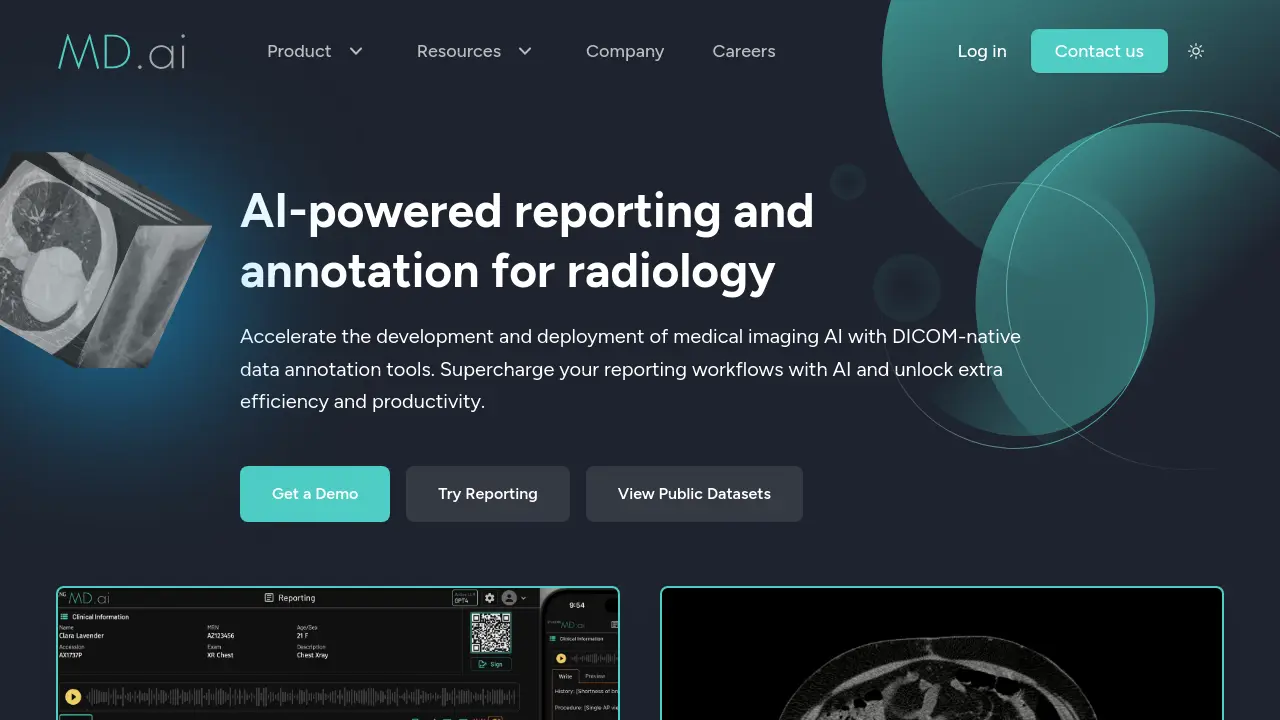MD.ai
AI-powered reporting and annotation for radiology

Description
MD.ai provides an advanced platform utilizing artificial intelligence to enhance radiology workflows. It offers specialized solutions for both AI-powered clinical reporting and DICOM-native data annotation, catering to the needs of medical professionals and AI developers. The system is designed to accelerate the development and deployment of medical imaging AI, while also supercharging reporting processes to unlock extra efficiency and productivity in clinical settings.
The reporting module leverages large language models (LLMs) to streamline tasks such as automatic template selection, mapping dictated key findings to reports, generating diagnostic impressions, and proofreading. For AI development, the annotator module facilitates the creation of large, high-quality labeled datasets with features like native DICOM support, an FDA 510(k)-cleared viewer, and AI-assisted annotation. MD.ai aims for seamless integration with existing healthcare systems like EHR/HIS/RIS through HL7/DICOM compatibility and offers multi-device accessibility for flexibility.
Key Features
- Automatic Template Selection: AI selects appropriate reporting templates for clinical workflows.
- Key Findings Dictation Mapping: Maps dictated findings to relevant sections in medical reports.
- Impression Generation: AI assists in generating diagnostic impressions based on findings.
- AI-Powered Proofreading: Offers AI-assisted review and correction of radiology reports.
- Automated Billing Code Generation: Streamlines administrative tasks by suggesting appropriate billing codes.
- Patient-Friendly Audio Messages: Creates audio summaries of reports to improve patient communication and education.
- Simple HL7/DICOM Integration: Enables connectivity with existing Electronic Health Records (EHR), Hospital Information Systems (HIS), and Radiology Information Systems (RIS).
- Multi-Device Sync: Allows work on desktop, laptop, tablet, or mobile devices with synchronized data.
- Multilingual Support: Supports multiple languages for diverse user bases and patient populations.
- Contextual AI Chat: Provides relevant AI-driven assistance and information within the reporting interface.
- Native DICOM Support: Works directly with Digital Imaging and Communications in Medicine (DICOM) files.
- FDA 510(k)-Cleared Viewer: Includes a medical image viewer that meets FDA regulatory standards.
- Seamless Scaling for Datasets: Efficiently handles large volumes of medical imaging data and numerous collaborators.
- AI-Assisted Annotation: Employs artificial intelligence to accelerate the process of labeling medical images.
- PHI Detection and De-ID: Identifies and removes Protected Health Information (PHI) to ensure data privacy.
- Developer APIs: Provides Application Programming Interfaces for custom integrations and workflow automation.
Use Cases
- Accelerating the development and deployment of medical imaging AI models.
- Supercharging clinical reporting workflows in radiology departments.
- Creating large, high-quality, labeled DICOM datasets for AI training.
- Deploying and validating AI-driven models in clinical practice.
- Streamlining administrative tasks such as medical billing code generation.
- Improving patient communication and understanding of medical findings through audio messages.
You Might Also Like
Epic AITravel Photos
Usage BasedCreate Stunning Travel Photos at Popular Destinations Without Leaving Home
Reve AI
FreeArtistic AI Image Generator for Stunning Text-to-Image Creations with Perfect Typography
Sanctum
FreeRun open-source LLMs locally and privately on your device
Get-offer.me
Free TrialThe perfect AI Interview Assistant
ToonCrafter AI
PaidTurn your photos into captivating cartoons with advanced AI technology.